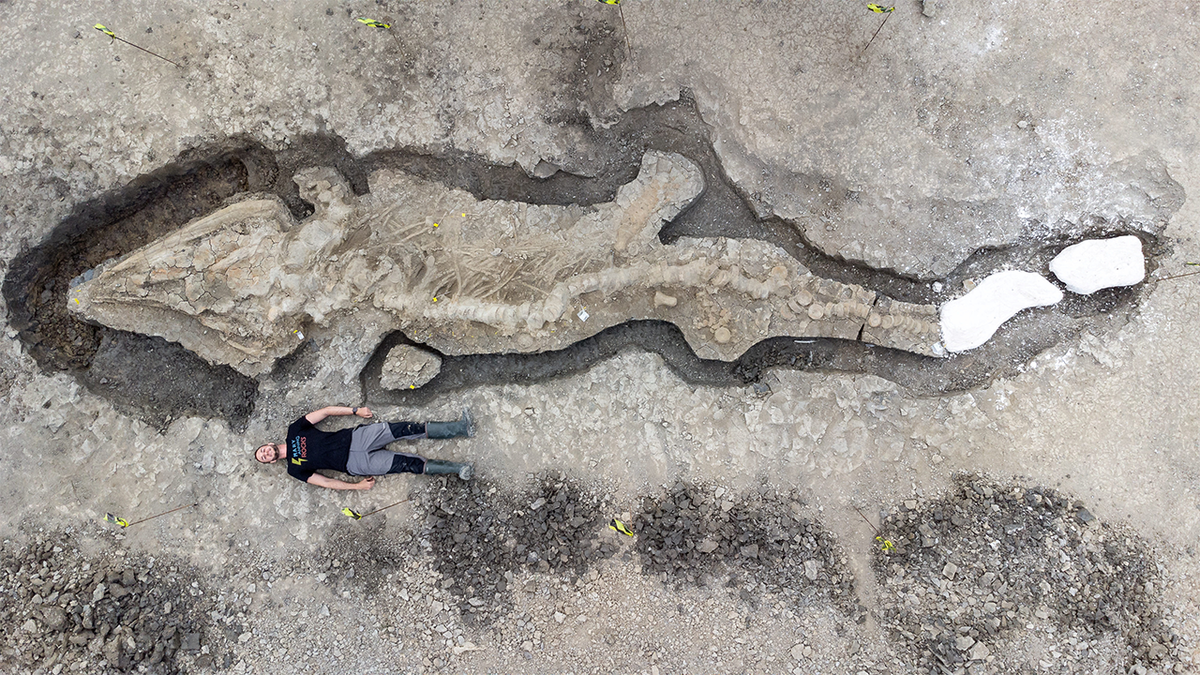Fox News Flash top headlines for January 10
Fox News Flash top headlines are here. Check out what's clicking on Foxnews.com.
Nature reserve workers in the U.K. have discovered the fossilized remains of a sea creature that existed some 180 million years ago during the Jurassic Period.
Workers found the 32-foot skeleton of the ichthyosaur – known colloquially as a "sea dragon" – in the Rutland Water Nature Reserve near Leicester.

A man poses next to excavated remains of a Britain's largest ichthyosaur, at Rutland Water, Rutland county, Britain, August 2021 in this picture obtained from social media on January 10, 2022. (Anglian Water/Matthew Power Photography via REUTERS)
The Leicestershire and Rutland Wildlife Trust, which manages the reserve in partnership with Anglian Water, said Monday that the skeleton is the "biggest and most complete skeleton of its kind found to date in the U.K."
Joe Davis, Rutland Water Conservation Team Leader, discovered the ichthyosaur during a routine draining of the lagoon island for re-landscaping last year.

Paleontologists work at a site where remains of Britain's largest ichthyosaur were found, at Rutland Water, Rutland County, Britain, August 2021, in this picture obtained from social media on January 10, 2022. (Anglian Water/Matthew Power Photography via REUTERS)
Davis said he noticed what looked like organic "clay pipes" sticking out of the mud. Upon closer inspection, he and Reserves Officer Paul Trevor determined that they looked like vertebrae.
"We followed what indisputably looked like a spine and Paul discovered something further along that could have been a jawbone," Davis said, according to the Wildlife Trust. "I couldn’t quite believe it."
TIME CAPSULE FOUND AT CONFEDERATE GEN. ROBERT E. LEE STATUE SITE REVEALS CIVIL WAR-ERA ARTIFACTS
At a little over 32 feet in length, the skull weighs approximately 2,200 lbs. The sea creature first appeared around 250 million years ago and went extinct approximately 90 million years ago. The marine reptiles were apex predators, meaning they were at the top of the food chaini. They also resembled dolphins in appearance and could be anywhere from 3 to 82 feet.

Joern Hurum (L), an assistant professor at the University of Oslo, stands next to a fossil of a "Monster" fish-like reptile in a 150 million-year-old Jurassic graveyard on the Arctic island of Spitsbergen, off Norway in this undated handout photo from the Natural History Museum, University of Oslo. (REUTERS/Natural History Museum, University of Oslo/Handout)
A team of paleontologists led by Dean Lomax excavated the skeleton between August and September 2021. It is believed to be the first ichthyosaur of its species, Temnodontosaurus trigonodon, discovered in the U.K.
CLICK HERE TO GET THE FOX NEWS APP
The remains are now being studied and conserved in Shropshire and will be later be returned to Rutland for permanent display, the BBC reported.






















